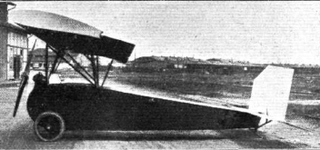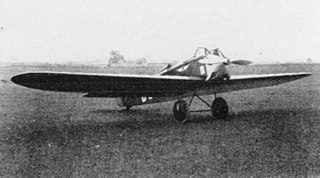
The Junkers T 19, originally known as the J 19, was a single-engined parasol winged all-metal 2/3-seat aircraft built in Germany in the early 1920s for training and touring. Its construction was too expensive for commercial success and only three were built, one later finding use as an engine test-bed.
The Koolhoven F.K.44 was a two-seat, single engine sport monoplane designed and built in the Netherlands in the early 1930s. It was built to order, but only one was completed.

The LFG Roland D.XVI, initially designated the LFG Roland E.I, was a single-seat, single-engine, parasol wing German fighter aircraft flown close to the end of World War I. Only two were built.

The LFG V 40 and V 44 were one-off, single-engine, two-seat sports monoplanes, identical apart from their engines, built in Germany in 1925.

The Albatros L.66 was a simple, low powered, two seat sports and training parasol wing monoplane, built in Germany in the mid-1920s.

The Albatros L.71 was a two-seat, single pusher engined biplane built in Germany in the 1920s.

The Udet U 1 was the first of a line of small, low-powered, low wing, cantilever monoplanes built in Germany in the early 1920s.
The Dietrich-Gobiet DP.VII was a simple, low power, German sports aircraft flown in early 1924.
The Régnier 12 was a 1930s Belgian touring aircraft offering variants with different engines and seating plans. Only one was built.
The Leduc RL-12 was a French low power, economical, parasol wing, single seat aircraft. First flown in July 1939, its development was halted by World War II.

The Mauboussin M.112, M-12 or Mauboussin M.XII was originally called the Peyret-Mauboussin PM XII and was renamed when Mauboussin founded his own company in 1931, ending his partnership with Louis Peyret. It was a French, single-engine, two-seat, low cantilever wing touring monoplane. At least six were built.
The unsuccessful French Farman F.200 of 1923 shared its type name with the 1929 Farman F.200, the progenitor of a series of parasol wing tourers. It was a two-seat touring aircraft, with a low, thick, cantilever wing. Only one was built and only briefly tested.

The parasol wing, single engine Udet U 8, sometimes referred to as the Limousine, was a three-seat commercial passenger transport designed and built in Germany in 1924. Five were produced and were used by German airlines until about 1928.

The Raab-Katzenstein KL.1 Schwalbe (Swallow) was a German two-seat biplane produced in the 1920s. About fifty were built and the type became well known as an aerobatic aircraft, performing at many displays in the hands of pilots like Gerhard Fieseler.
The Działowski D.K.D.4 was a Polish, parasol-wing, sports two-seater built in 1928. One won the Second National Lightplane Contest, with another coming fifth.

The Sido S.1 was a Polish two seat, parasol wing trainer aircraft, first flown in 1930.
The Nordflug FB 1 was a small, parasol wing flying boat with two seats in tandem, sponsons for stability on the water and a low-powered, wing mounted engine.
The Brown 1926 parasol monoplane was a 1920s US, three seat, parasol wing civil aircraft developed from a biplane wartime scout. It was intended for either the private or commercial passenger markets, though one was used as a crop-duster.
The Yackey Monoplane was an American three seat parasol monoplane flown in the late 1920s. Two prototypes had some success in the 1927 New York - Spokane National Air Derby and orders were placed but a crash killed its designer and ended production.

The Zenith Albatross Z-12 was a large, three-engined airliner built in the United States in 1928. It could carry up to 11 passengers. Only one was completed.












